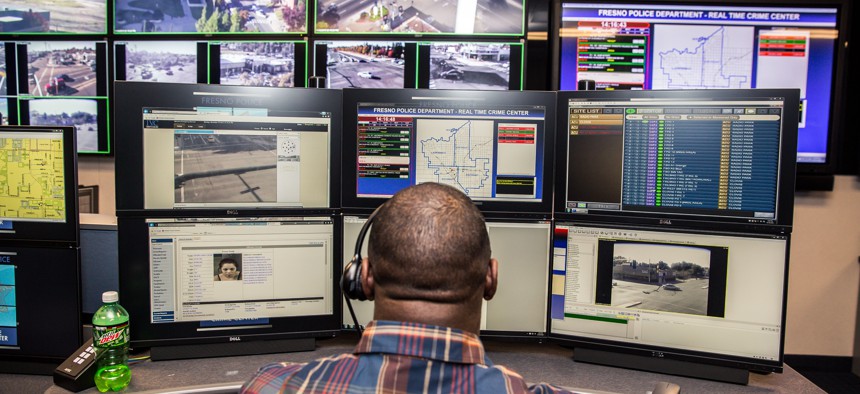The 6 Fundamentals of an Effective Real-Time Crime Center

Fresno Police officers can be seen inside the Fresno Police Department's real time crime center manning computers. The Washington Post / Contributor via Getty Images
COMMENTARY | These centers, which can help police investigators develop leads and share crucial information with other officers and agencies, are becoming more common. Here's how to make them more effective.
Real-time crime centers bring humans and technology together to analyze and investigate regional crimes, trends and incidents. As a result, these centers can help investigators develop leads and share actionable information with other officers and law enforcement agencies for a quick response.
More regional police and sheriff departments are creating real-time crime centers to share resources across jurisdictions due to staffing and budget constraints. At the forefront of establishing these centers include police departments in Albuquerque, New Mexico; Austin, Texas; Fresno, California; Memphis, Tennessee; and New York City, to name a few.
Although RTCCs are becoming more common, the increasingly vast amount of data, information and intelligence coming into them can be difficult to manage without dedicated, trained personnel and the right tools.
From my experience, there are six pillars needed to make RTCCs most effective.
- A strong, cloud-based centralized intelligence platform capable of extracting and unifying video and data feeds from any source. With such a resource, the RTCC can create a central hub that strengthens the situational awareness and investigative capabilities of law enforcement and public safety agencies.
- Video and artificial intelligence-powered analytics. Smart technology solutions such as biometrics, facial recognition, smart cameras and video surveillance systems are growing in importance as municipalities and towns work to reduce crime and response times for emergency services, RTCCs also use automated license plate readers to track and get real-time alerts on the locations of vehicles, and they can tap into a variety of criminal justice databases and social media feeds.
- Open-source intelligence. OSINT is data that can be collected from publicly accessible sources on the surface, deep and dark web, such as forums, blog posts, news sources, articles, archives, interviews and documents as well as social media posts and video that can be freely accessed. OSINT gives law enforcement a wealth of information on the tactics, techniques and procedures used by criminals. AI-powered OSINT is vital for threat intelligence, providing law enforcement greater insights into emerging threats and vulnerabilities.
- Forensics. With so much information that can help law enforcement solve cases hidden in mobile devices such as cell phones and laptop computers, robust forensic tools are critical. In fact, forensic digital investigation solutions and AI-powered OSINT platforms are enhancing law enforcement’s ability to locate missing persons, find victims of human trafficking and identify criminals in fraud and extortion cases. The information collected from these devices and made accessible to the RTCC can provide crucial and previously unidentified elements that support tactical and real-time operations. Data from associates, family members, photographs, locations and more all can lead to developing a 360-degree pattern of life that may be essential in negotiations, apprehensions, identification, recovery and more.
- Gunshot detection and ballistics identification technology. Some cities have installed sensors throughout neighborhoods to listen for and locate sources of suspected gunfire, enabling police to more quickly respond. Bullet casings can, in turn, be identified by National Integrated Ballistic Information Network environments (such as onsite or local gun crime labs) and matched to crimes committed with the same firearm. When combined with other relevant information such as institutional knowledge and informant information, ballistics intelligence informs investigations and supports court cases.
- Trained staff. Besides the technology, an RTCC needs the right people who are trained in how to use the tools in a real-time scenario. Specialized units such as SWAT teams, motorcycle units, aviation or diving teams, are highly trained and selected. The same needs to be true for RTCC staff. These centers need skilled employees and leaders who can leverage the technologies to make incident response more effective.
Law enforcement needs information that can get well-informed officers to the scene quickly, and RTCCs provide that dedicated resource. However, RTCC officers and analysts must have access to the pillar technologies outlined above and the skilled staff to use that technology effectively so officers and investigators on location have actionable information when and where they need it.
Johnmichael O’Hare is director of business development and sales at Cobwebs Technologies and a retired commander of the vice, intelligence, and narcotics division for the Hartford Police Department.
NEXT STORY: Federal Covid Changes Helped Feed Twice as Many Kids During Summer





